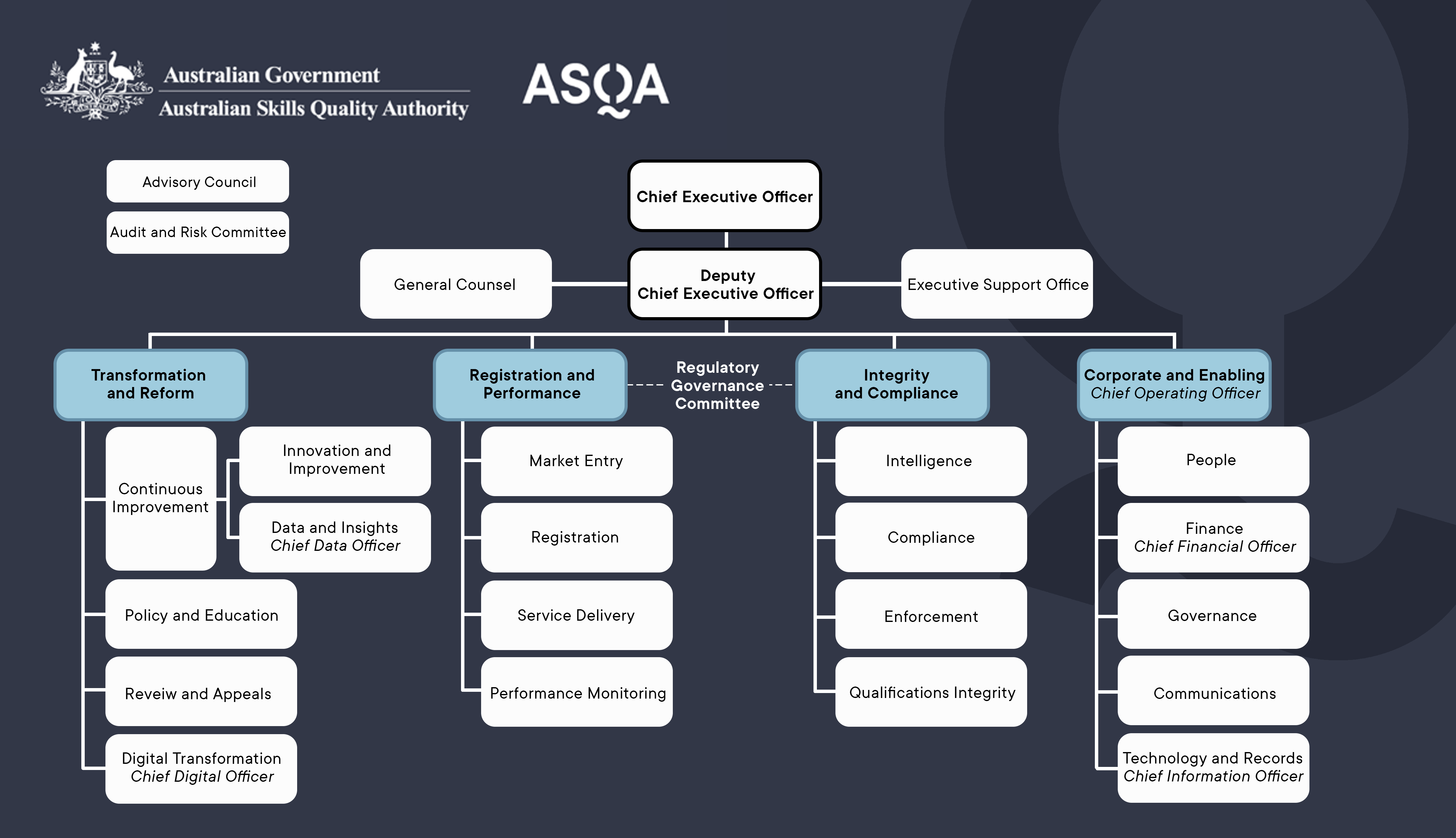- Home
- About us
- ASQA overview
- Our leadership and organisation
Our leadership and organisation
The Accountable Authority is ASQA’s Chief Executive Officer (CEO), who is appointed for a period of five years.
The Hon Andrew Giles MP, Minister for Skills and Training, provided ASQA with a Ministerial Statement of Expectations on 6 March 2025.
The Ministerial Statement of Expectations outlines Minister Giles’s expectations of ASQA as a best-practice regulator, with a dual purpose to protect and enhance quality, flexibility and innovation in vocational education and training (VET) as well as protect and enhance Australia’s reputation for VET nationally and internationally.
In line with the Regulator Performance Guide, ASQA has developed a Statement of Intent in response to these expectations, which was submitted to the Minister in May 2025.
Our Statement of Intent outlines our key priorities and how we intend to meet the Minister’s expectations.
Chief Executive Officer
CEO Saxon Rice has extensive experience across the VET and employment services sectors as well as the public policy process. Ms Rice previously held a range of senior government, VET and management positions. She was Assistant Minister for Technical and Further Education in the former Queensland Government from 2012 to 2015, and Chair of the then Ministerial Industry Commission responsible for industry engagement.
Ms Rice is a former Director of Global Business Development for an Australian employment services company and was responsible for significant growth into new countries in the European and Asian markets. Ms Rice has also served in a range of Senate Committee Secretariats, including as Acting Secretary and Principal Research Officer to the Senate Foreign Affairs, Defence and Trade Committee. More recently, she was a Member of the Administrative Appeals Tribunal from 2016 to 2018 and is a Member and Graduate of the Australian Institute of Company Directors.
Ms Rice commenced as a Commissioner of ASQA on 16 April 2018, before being appointed as Chief Commissioner and CEO (initially Acting) on 7 October 2019. With effect from 1 January 2021, Ms Rice was appointed CEO for a period of 5 years. The CEO and Accountable Authority plays a critical leadership and governance role and is responsible for ASQA’s statutory and regulatory oversight, strategic leadership, governance and risk management, performance and accountability, and cultural and organisational stewardship.
Deputy Chief Executive Officer
Penny McKay commenced as Deputy CEO in May 2025.
Prior to commencing at ASQA, Penny held the statutory appointment of Deputy Commonwealth Ombudsman for over 4 years, overseeing Commonwealth and ACT government agencies to influence systemic improvement in government administration. She has extensive experience in State, Territory and Commonwealth government agencies, largely in areas of integrity, oversight, criminal law policy and prosecutions. Penny has held senior positions in the Australian Public Service including acting First Assistant Secretary Integrity, Security and Assurance at the Department of Home Affairs and General Counsel at the Australian Commission for Law Enforcement Integrity.
During her career, Penny has worked as a Commonwealth, State and Territory prosecutor in the ACT, NT and Queensland. She is also an independent member of the Administrative Appeals Tribunal Audit and Risk Committee.
Senior Leadership
Fiona O'Brien, Executive Director, Transformation and Reform. With a future focus steering programs and projects though Continuous Improvement, Innovation, Data, Policy and Education advice to inform VET sector and whole of government regulatory reform, Review and Appeals, and ASQA’s Digital Transformation.
Denise Lowe-Carlus, Executive Director, Registration and Performance. Responsible for leading a number of regulatory teams at ASQA including Market Entry, Registration, Service Delivery, and Performance Monitoring.
Carmen Basilicata, Executive Director, Integrity and Compliance. Responsible for Intelligence, Compliance, Enforcement operations to prevent and detect threats to the integrity of VET, and to deter and disrupt illegal behaviour and the exploitation of vulnerable students. Carmen is also responsible for management of impacts on issued qualifications ensuring qualification validity.
Ty Emerson, Executive Director, Corporate and Enabling (Chief Operating Officer). Responsible for leading ASQA’s People , Finance , Governance, Communications, Technology and Records functions. Ty is also ASQA’s Diversity Champion, and Privacy Champion.
Organisation structure
Below is ASQA’s national organisation structure, as at 1 October 2025.

Related links
Share
